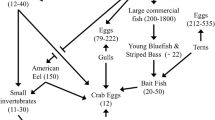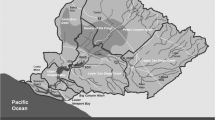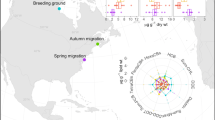Abstract
Subsurface agricultural drainage waters from western San Joaquin Valley, California, were found to contain elevated concentrations of the element selenium in the form of selenate. In 1978, these drainage waters began to replace previous input to Kesterson Reservoir, a pond system within Kesterson National Wildlife Refuge; this substitution was completed by 1982. In the 1983 nesting season, unusual rates of deformity and death in embryos and hatchlings of wild aquatic birds (up to 64% of eared grebe and American coot nests) occurred at the refuge and were attributed to selenium toxicosis. Features necessary for contamination to have taken place included geologic setting, climate, soil type, availability of imported irrigation water, type of irrigation, and the unique chemical properties of selenium. The mechanisms of biogeochemical cycling raise questions about other ecosystems and human exposure.
Similar content being viewed by others
Literature cited
Allaway, W. H. 1968. Control of the environmental levels of selenium. Pages 181–206in D.D. Hemphill (ed.), Proceedings of 2nd annual conference on trace substances in environmental health. University of Missouri, Columbia, Missouri.
Anderson, M. S., H. W. Lakin, K. C. Beeson, F. F. Smith, and E. Thacker. 1961. Selenium in agriculture. Agriculture handbook 200. US Department of Agriculture, Washington, DC, 65 pp.
Berner, R. A. 1984. Sedimentary pyrite formation: an update.Geochimica et Cosmochimica Acta 48:605–615.
Byers, H. G. 1935. Selenium occurrence in certain soils in the U.S. with a discussion of related topics. US Department of Agriculture Technical Bulletin 482, pp. 1–47.
Byers, H. G. 1936. Selenium occurrence in certain soils in the U.S. with a discussion of related topics: second report, US Department of Agriculture Technical Bulletin 530, pp. 1–79.
Byers, H. G., J. T. Miller, K. T. Williams, and H. W. Lakin. 1938. Selenium occurrence in certain soils in the U.S. with a discussion of related topics: third report. US Department of Agriculture Technical Bulletin 601, pp. 1–75.
California DFG and SWRCB (Department of Fish and Game and State Water Resources Control Board). 1986. High selenium levels found in Suisun Bay duck: joint news release. Resources Agency, California DFG and SWRCB, Sacramento, California, 4 pp.
California SWRCB (State Water Resoures Control Board). 1985. Hearing order WQ 85-1. California SWRCB, Sacramento, California, 65 pp.
Cardwell, R. D., T. C. Carver, P. H. Davies, J. P. Goettl, P. V. Hodson, and S. J. Olsen. 1979. Selenium. Pages 247–256in R. V. Thurston, R. C. Russo, C. M. Fetterolf, T. A. Edsall, and Y. M. Barber (eds.), A review of the EPA Red Book: quality criteria for water. Water Quality Section, American Fisheries Society, Bethesda, Maryland.
Craig, H. 1961. Isotopic variations in meteoric waters.Science 133:1702–1703.
Cutter, G. A. 1978. Species determination of selenium in natural waters.Analytica Chimica Acta 98:59–66.
Davis, G. H., and J. F. Poland. 1957. Ground water conditions in the Mendota—Huron area, Fresno and Kings counties, California. US Geological Survey Water-Supply Paper 1360-G, pp. 409–588.
Ehrlich, H. L. 1978. Inorganic energy sources for chemolithotropic and mixotropic bacteria.Geomicrobiology Journal 1:65–83.
Finley, K. A. 1985. Observations of bluegills fed selenium contaminatedHexagenia nymphs collected from Belews Lake, North Carolina.Bulletin of Environmental Contamination and Toxicology 35:816–825.
Fishbein, L. 1977. Toxicology of selenium and tellurium. Pages 191–240in R. A. Goyer and M. A. Mehlman (eds.), Toxicology of trace elements. Hemisphere, Washington, DC.
Fontes, J.-C., and R. Gonfiantini. 1967. Comportment isotopique au cours de l'evaporation de deux bassins sahariens.Earth and Planetary Science Letters 3:258–266.
Geering, H. R., E. E. Carey, L. H. P. Jones, and W. H. Allaway. 1968. Solubility and redox criteria for the possible forms of selenium in soils.Soil Science Society of America Proceedings 32:35–40.
Gillespie, R. B., and P. C. Baumann. 1986. Effects of high tissue concentrations of selenium on reproduction by bluegills.Transactions of the American Fisheries Society 115:208–213.
Gilmer, D. S. 1984. A discussion of the biologic system. Pages 16–17in U.S. Bureau of Reclamation and Ecological Analysts, Proceedings of a research meeting on toxicity problems at Kesterson Reservoir, CA. US Bureau of Reclamation, Mid-Pacific Region, Sacramento, California.
Gilmer, D. S., M. R. Miller, R. D. Bauer, and J. R. LeDonne. 1982. California's Central Valley wintering waterfowl: concerns and challenges.Transactions of the North American Wildlife and Natural Resources Conference 47:441–452.
Greenberg, A.J. 1985. Statement to the joint hearing, California Senate Committees on agriculture and water, toxics and public safety, health and human services. Toxics Information Project, Larkspur, California.
Greensberg, A.J., and D. Kopec. 1986. Decline of Bay-Delta fisheries and increased selenium loading: possible correlation. Pages 69–81in A.Q. Howard (ed.), Proceedings of the symposium on selenium in agricultural drainage: implications for the San Francisco Bay and the California environment. University of California, Berkeley, California.
Gunn, A. M. 1981. The determination of arsenic and selenium in raw and potable waters by hydride generation/ atomic absorption spectrometry: a review. Technical Report TR169. WRC Environmental Protection, Medmenham, Marlow, Bucks, Great Britain, 76 pp.
Hackel, O. 1966. Summary of the geology of the Great Valley, pages 217–238in E. H. Bailey (ed.), Geology of northern California. California Division of Mines and Geology Bulletin 190. San Francisco, California.
Heinz, G. H., D.J. Hoffman, A.J. Krynitsky, and D. M. G. Weller. 1987. Reproduction in mallards fed selenium.Environmental Toxicology and Chemistry 6:423–433.
Hem, J. D. 1970. Study and interpretation of the chemical characteristics of natural water. US Geological Survey Water-Supply Paper 1473, pp. 207–208.
Hoffman, D.J. 1984. A discussion of the biologic system. Pages 20–21in U.S. Bureau of Reclamation and Ecological Analysts, Proceedings of a research meeting on toxicity problems at Kesterson Reservoir, CA. US Bureau of Reclamation, Mid-Pacific Region, Sacramento, California.
Hoffman, D.J., B. A. Rattner, L. Sileo, D. Docherty, and T. J. Kubiak. 1987. Embryotoxicity, teratogenicity, and aryl hydrocarbon hydroxylase activity in Forster's terns on Green Bay, Lake Michigan.Environmental Research 42:176–184.
Howard, J. H. 1977. Geochemistry of selenium: formation of ferroselite and selenium behavior in the vicinity of oxidizing sulfide and uranium deposits.Geochimica et Cosmochimica Acta 41:1665–1678.
Izbicki, J. A. 1984. Chemical quality of water at fourteen sites near Kesterson National Wildlife Refuge, Fresno and Merced counties, California. US Geological Survey Open-File Report 84-582, pp. 1–9.
Jennings, C. W. 1977. Geologic map of California, scale 1∶750,000. California Division of Mines and Geology, Sacramento, California.
Kharaka, Y. K., and I. Barnes. 1973. SOLMNEQ: solution mineral equilibrium computations. US Geological Survey Computer Contribution WRD-73-002:1–82 (NTIS PB-215-899).
Konetzka, W. A. 1977. Microbiology of metal transformations. Pages 317–342in E. D. Weinberg (eds), Microorganisms and minerals. Marcel Dekker, New York.
Lakin, H. W. 1961. Geochemistry of selenium in relation to agriculture. Pages 3–12in M.S. Anderson, H. W. Lakin, K. C. Beeson, F. F. Smith, and E. Thacker (eds.), Selenium in agriculture. Agriculture Handbook 200. US Department of Agriculture, Washington, DC.
Lakin, H. W., and H. G. Byers. 1941. Selenium occurrence in certain soils in the U.S. with a discussion of related topics: sixth report. US Department of Agriculture Technical Bulletin 783, pp. 1–27.
Lemly, A. D. 1985a. Toxicology of selenium in a freshwater reservoir: implications for environmental hazard evaluation and safety.Ecotoxicology and Environmental Safety 10:314–338.
Lemly, A. D. 1985b. Ecological basis for regulating aquatic emissions from the power industry: the case with selenium.Regulatory Toxicology and Pharmacology 5:405–486.
Lipman, J. G., and S. A. Waksman. 1923. The oxidation of selenium by a new group of autotropic microorganisms.Science 57:60.
Lo, L. W., J. Koropatnick, and H. T. Stich. 1978. The mutagenicity and cytotoxicity of selenite, “activated” selenite, and selenate for normal and DNA repair-deficient human fibroblasts.Mutation Research 49:305–312.
Lo, M.-T., and E. Sandi. 1980. Selenium: occurrence in foods and its toxicological significance: a review.Journal of Environmental Pathology and Toxicology 4:193–218.
Marsh, J. A., G. J. Combs, and R. R. Dietert. 1981. Effects of selenium and vitamin E on the development of humoral immunity of the chick. Pages 358–365in J. E. Spallholz, J. L. Martin, and H. E. Ganther (eds.), Selenium in biology and medicine. AVI, Westport, Connecticut.
McClelland, E. J. 1984. Preliminary results of analysis of bottom sediments, San Luis Drain: data transmittal. US Geological Survey, Sacramento, California, 2 pp.
Mendenhall, W. C., R. B. Dole, and H. Stabler. 1916. Ground water in the San Joaquin Valley, California. US Geological Survey Water-Supply Paper 398, pp. 1–310.
Miller, W. J. 1957. California through the ages. Westernlore, Los Angeles, California, 264 pp.
Murata, K. J. 1977. Occurrence of bloedite and related minerals in marine shale of Diablo and Temblor Ranges, California.Journal of Research of the US Geological Survey 5:637–642.
Muth, O. H., J. E. Oldfield, and P. H. Weswig (eds.). 1967. Symposium: selenium in biomedicine. AVI, Westport, Connecticut, 271 pp.
Nakahara, T. 1983. Applications of hydride generation techniques in atomic absorption, atomic fluorescence, and plasma atomic emission spectroscopy.Progress in Analytical Atomic Scpectroscopy 6:163–223.
NAS (National Academy of Sciences). 1976. Selenium: medical and biologic effects of environmental pollutants. NAS, Washington, DC, 203 pp.
NAS (National Academy of Sciences). 1977. Pages 344–474in Drinking water and health. NAS, Washington, DC.
NAS (National Academy of Sciences) Food and Nutrition Board. 1980. Recommended dietary allowances, 9th rev. edn. National Research Council, NAS, Washington, DC, 162 pp.
NOAA (National Oceanic and Atmospheric Administration). 1982. Annual summary.Climatological Data California 86(13):1–52.
Nichols, F. H., J. E. Cloern, S. N. Luoma, and D. H. Peterson. 1986. The modification of an estuary.Science 231:567–573.
Noda, M., T. Takano, and H. Sajurai. 1979. Mutagenic activity of selenium compounds.Mutation Research 66:175–179.
North Carolina DNR&CD (Department of Natural Resources and Community Development). 1986. North Carolina water quality standards documentation: the freshwater chemistry and toxicity of selenium with an emphasis on its effects in North Carolina. North Carolina DNR&CD, Division of Environmental Management, report 86-02, Raleigh, North Carolina.
Ohlendorf, H. M. 1984. The biologic system. Pages 8–15in U.S. Bureau of Reclamation and Ecological Analysts, Proceedings of a research meeting on toxicity problems at Kesterson Reservoir, CA. US Bureau of Reclamation, Mid-Pacific Region, Sacramento, California.
Ohlendorf, H. M. 1987. Bioaccumulation and effects of selenium in wildlife.In L. W. Jacobs et al. (eds.), Selenium in irrigated agriculture. Special Publication, American Society of Agronomy, Madison, Wisonsin (in press).
Ohlendorf, H. M., D. J. Hoffman, M. K. Saiki, and T. W. Aldrich. 1986a. Embryonic mortality and abnormalities of aquatic birds: apparent impacts by selenium from irrigation drainwater.Science of the Total Environment 52:49–63.
Ohlendorf, H. M., R. L. Hothem, C. M. Bunck, T. W. Aldrich, and J. F. Moore. 1986b. Relationships between selenium concentrations and avian reproduction.Transactions of the North American Wildlife and Natural Resources Conferences 51:330–342.
Ohlendorf, H. M., R. W. Lowe, P. R. Kelly, and T. E. Harvey. 1986c. Selenium and heavy metals in San Francisco Bay diving ducks.Journal of Wildlife Management 50:64–71.
Ohlendorf, H. M., R. L., Hothem, T. W. Aldrich, and A. J. Krynitsky. 1987a. Selenium contamination of the Grasslands, a major California waterfowl area.Science of the Total Environment (in press).
Ohlendorf, H. M., A. W. Kilness, J. L. Simmons, R. K. Stroud, D.J. Hoffman, and J. F. Moore. 1987b. Selenium toxicosis in wild aquatic birds.Journal of Toxicology and Environmental Health (in press).
Ort, J. F., and J. D. Latshaw. 1978. The toxic level of sodium selenite in the diet of laying chickens.Journal of Nutrition 108:1114–1120.
Pierce, F. D., and H. R., Brown. 1977. Comparison of inorganic interferences in atomic absorption spectrometric determination of arsenic and selenium.Analytical Chemistry 49:1417–1422.
Poley, W. E., A. L. Moxon, and K. W. Franke. 1937. Further studies of the effects of selenium poisoning on hatchability.Poultry Science 16:219–225.
Presser, T. S., and I. Barnes. 1984. Selenium concentrations in waters tributary to and in the vicinity of Kesterson National Wildlife Refuge, Fresno and Merced counties, California, US Geological Survey Water Resources Investigations Report 84-4122, pp. 1–26.
Presser, T. S., and I. Barnes. 1985. Dissolved constituents including selenium in waters in the vicinity of Kesterson National Wildlife Refuge and the west Grassland, Fresno and Merced counties, California. US Geological Survey Water Resources Investigations Report 85-4220, pp. 1–73.
Rantz, S. E. 1969. Map of the mean annual precipitation in the California Region. US Geological Survey Basic Data Compilation. Water Resources Division, Menlo Park, California.
Rascati, R.J. 1983. Induction of retrovirus gene expression by selenium compounds.Mutation Research 117:67–78.
Rosenfeld, I., and O. A. Beath. 1964. Selenium: geobotany, biochemistry, toxicity and nutrition. Academic Press, New York.
Russell, G. R., C. J. Nader, and E. J. Patrick. 1980. Induction of DNA repair by some selenium compounds.Cancer Letters 10:75–81.
Saiki, M. K. 1986. A field example of selenium contamination in an aquatic food chain. Pages 67–75in Proceedings from the first annual symposium on selenium in the environment. California Agricultural Technology Institute Publication CATI/860201. California State University, Fresno, California.
Sakurai, H., and K. Tsuchiya. 1975. A tentative recommendation for maximum daily intake of selenium.Environmental and Physiologcal Biochemistry 5:107–118.
Schwarz, K., and C. M. Foltz. 1957. Selenium as an integral part of Factor 3 against dietary necrotic liver degeneration.Journal of the American Chemical Society 79:3292–3293.
Shamberger, R. J. 1983. Biochemistry of selenium. Plenum, New York, 334 pp.
Shrift, A. 1964. A selenium cycle in nature?Nature 201:1304–1305.
Sliwkowski, M. X., and T. C. Stadtman. 1987. Purification and immunological study of selenoprotein A of the clostridial glycine reductase complex.Journal of Biological Chemistry 262:4899–4904.
Sorensen, E. M. B., P. M. Cumbie, T. L. Bauer, J. S. Bell, and C. W. Harlan. 1984. Histopathological, hematological, condition-factor, and organ weight changes associated with selenium accumulation in fish from Belews Lake, North Carolina.Archives of Environmental Contamination and Toxicology 13:153–162.
Spallholz, J. E., J. L. Martin, and H. E. Ganther (eds.). 1981. Selenium in biology and medicine. AVI, Westport, Connecticut, 573 pp.
Stadtman, T. C. 1974. Selenium biochemistry.Science 183:915–922.
Torma, A. E., and F. Habashi. 1972. Oxidation of copper (II) selenide byTiobacillus ferrooxidans.Canadian Journal of Microbiology 18:1780–1781.
Trelease, S. F., and O. A. Beath. 1949. Selenium, its geological occurrence and its biological effects in relation to botany, chemistry, agriculture, nutrition, and medicine. Champlain, Burlington, Vermont, 292 pp.
USBR (US Bureau of Reclamation). 1976. Central Valley Project factual data sheet. USBR, Mid-Pacific Region, Sacramento, California, 2pp.
USBR (US Bureau of Reclamation). 1982. San Luis Drain: status of study plans for completion of report of discharge prepared for the California State Water Resources Control Board. USBR, Mid-Pacific Region, Sacramento, California, 20 pp.
USBR (US Bureau of Reclamation). 1984a. San Luis Unit, Central Valley Project, California. Information Bulletins 1, 2, 3, and 4. USBR, Mid-Pacific Region, Sacramento, California.
USBR (US Bureau of Reclamation). 1984b. Statement by David G. Houston presented to California Assembly Water, Parks and Wildlife Committee. USBR Mid-Pacific Region, Sacramento, California.
USBR (US Bureau of Reclamation). 1985. Water quality analyses, West Side-San Joaquin Valley, CA. USBR, Mid-Pacific Region, Sacramento, California, 72 pp.
USBR (US Bureau of Reclamation). Mid-Pacific Region, in Cooperation with US Fish and Wildlife Service and US Army Corps of Engineers. 1986. Final environmental impact statement: Kesterson program, vols. 1 and 2. USBR, Mid-Pacific Region, Sacramento, California.
USDOI (US Department of the Interior). 1985. Task group on Irrigation Drainage. Preliminary evaluation of selenium concentrations in ground and surface water, soils, sediment, and biota from selected areas in the Western U.S. USDOI, Office of the Secretary, Washington, DC, 126 pp.
USDOI (Department of the Interior). 1986. Task group on irrigation drainage. Page 3in Plan for irrigation quality activities: protocol for conducting field screening studies. USDOI, Office of the Secretary, Washington,DC.
SEPA (US Environmental Protection Agency). 1977. National interim primary drinking water regulations (EPA-570/9-76-003). USEPA, Office of Water Supply, Washington, DC, 159 pp.
USEPA (US Environmental Protection Agency). 1978. (1976). Quality criteria for water. USEPA, Office of Water Planning and Standards, Washington, DC, 256 pp.
USEPA (US Environmental Protection Agency). 1979. Selenium. Pages 16–1 to 16–13in Water-related environmental fate of 129 priority pollutants, vol. 1 (EPA-440/4-79-029a). USEPA, Washington, DC.
USEPA (US Environmental Protection Agency). 1980a. Adopted water quality criteria for protection of freshwater aquatic life.Federal Register 45:79,318–79,379.
USEPA (US Environmental Protection Agency). 1980b. Hazardous waste management system.Federal Register 45:33,063–33,285.
USEPA (US Environmental Protection Agency). 1980c. Ambient water quality criteria for selenium (EPA-440/5-80-070). USEPA, Washington, DC 131 pp.
USF&WS (US Fish and Wildlife Service). 1978. Concept plan for waterfowl wintering habitat preservation: Central Valley, California. USF&WS, Portland, Oregon.
WWD (Westlands Water District). 1984. The drainage problem in the Western San Joaquin Valley. WWD, Fresno, California, 10 pp.
Wilber, C. G. 1980. Toxicology of selenium: a review.Clinical Toxicology 17:171–230.
Wilber, C. G. 1983. Selenium, a potential poison and a necessary food constituent. Charles Thomas, Springfield, Illinois, 126 pp.
Williams, K. T., H. W. Lakin, and H. G. Byers. 1940. Selenium occurrence in certain soils in the U.S. with a discussion of related topics: fourth report. US Department of Agriculture Technical Bulletin 702, pp. 1–60.
Williams, K. T., H. W. Lakin, and H. G. Byers. 1941. Selenium occurrence in certain soils in the U.S. with a discussion of related topics: fifth report. US Department of Agriculture Technical Bulletin 758, pp. 1–70.
Wittwer, A.J., L. Tsai, W.-M. Ching, and T. C. Stadtman. 1984. Identification and synthesis of naturally occurring selenonucleoside in bacterial tRNAs: 5-[(methylamino)- methyl]-2-selenouridine.Biochemistry 23:4650–4655.
Yang, G., S. Wang, R. Zhou, and S. Sun, 1983. Endemic selenium intoxication of humans in China.American Journal of Clinical Nutrition 37:872–881.
Zinoni, F., A. Birkmann, T. C. Stadtman, and A. Böck. 1986. Nucleotide sequence and expression of selenocysteine-containing polypeptide of formate dehydrogenase fromEscherichia coli.Proceedings of the National Academy of Sciences USA 83:4650–4654.
Author information
Authors and Affiliations
Rights and permissions
About this article
Cite this article
Presser, T.S., Ohlendorf, H.M. Biogeochemical cycling of selenium in the San Joaquin Valley, California, USA. Environmental Management 11, 805–821 (1987). https://doi.org/10.1007/BF01867247
Issue Date:
DOI: https://doi.org/10.1007/BF01867247




